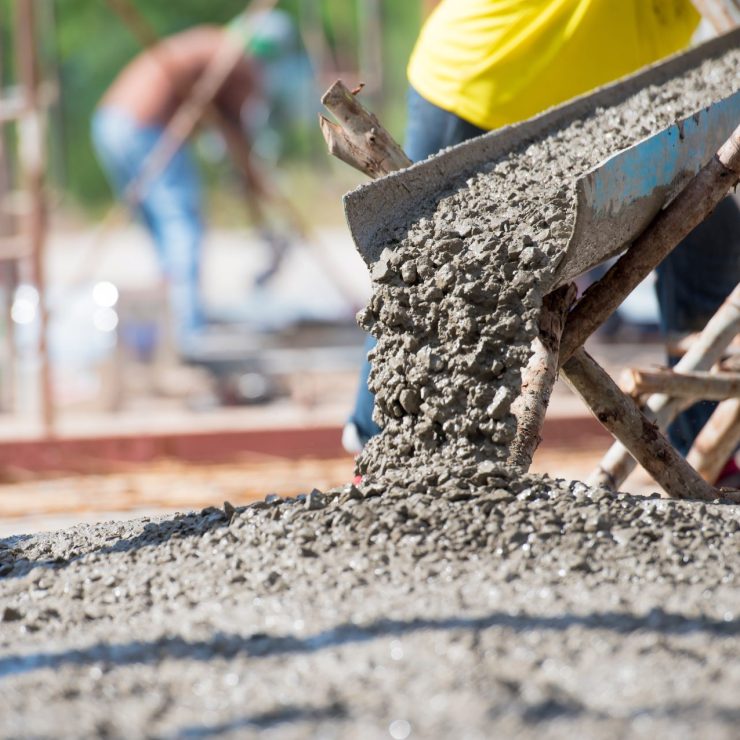By: Katie Tich, LEED AP BD+C, GGP
It’s impossible to interact with our world without encountering concrete. Concrete is the most-produced material on earth [1] – its structural strength and diverse applications have contributed to its long-lasting ubiquity across the globe. When you walk outside, there’s a concrete sidewalk under your feet. Concrete makes up a huge portion of the buildings we live, work, and play in; it makes up the structures that store our drinking water, supports the earth under our cities, and allows us to build bridges that connect our world. It has been a staple of human society for thousands of years, from the pozzolanic concrete [2] in Roman aqueducts to Nabataean concrete cisterns for desert water storage in 6500 B.C. [3]
Much like industrialization and fossil fuels created the foundation for our modern, interconnected lifestyle, the use of concrete in the built environment has been incredibly influential in human development, albeit over a much longer time scale. However, a more recent problem has come to light in the fight against climate change – like fossil fuels, concrete is a significant contributor to global carbon emissions. It is critical that we find ways to mitigate, and eventually eliminate, the substantial amount of carbon produced by concrete. But why does concrete have such a high carbon footprint? A huge portion of it comes from the process of creating cement.
Cement is the main active ingredient that gives concrete its strength. It is a binding material containing limestone that is mixed with aggregate materials like stone, gravel, and sand to form concrete mixes. There are many different types of cement, but the most common type used in modern construction is Portland cement. To create Portland cement, limestone must first go through a chemical process called calcination, which has a major byproduct – carbon dioxide. In addition, making cement requires heating, mixing, and cooling the raw materials, which releases – you guessed it – more carbon dioxide.
You might wonder, “why wouldn’t the construction industry shift to another material?”, especially since concrete is responsible for a staggering 7% of global carbon emissions. [4] Materials like concrete are hard to find. The trifecta of low cost, high durability, and high structural strength is virtually unmatched. So, if concrete is here to stay, how can we reap the benefits without suffering the carbon-intensive consequences?
This week we will examine some structural solutions that can be implemented in the built environment to reduce the amount of cement used. Next week, we will introduce ways to replace cement with other materials and discuss more innovative solutions to mitigate cement’s carbon footprint.
Reusing Existing Buildings
One way to reduce the environmental impact of concrete is to simply use less concrete. This doesn’t sound revolutionary, but with how widespread and effective concrete is as a structural system, the construction industry will have to be intentional about prioritizing efficiency.
The easiest way to use less concrete in construction is to take advantage of the concrete we already have. There is a temptation in building projects to create something from the ground up, but often the most innovative and cutting-edge projects involve the adaptive reuse of existing structures. Reusing existing buildings is by far the best way to reduce carbon emissions from the built environment – recycling structures has been shown to reduce carbon emissions by up to 40%. [5] Building reuse also reduces demolition and construction waste and allows for architectural creativity to adapt all kinds of historic spaces for modern use. Energy efficiency is sometimes a concern, since older buildings tend to have less efficient HVAC systems and ineffective sealing and insulation, but modern retrofits have proved to be effective at bringing historic structures up to modern energy use standards. [6]
Countless historic structures sit empty and unused, as we continue producing new concrete and increasing our developmental and environmental footprint. As a society, reusing buildings allows us to drastically reduce these impacts, and preserve aspects of our cultural heritage while simultaneously incorporating our history seamlessly into our current lives. Catalyst Partners, a sustainability consulting firm in Michigan, turned a historic flour mill into their corporate headquarters and earned a LEED Platinum certification. [7] Architecture firm Becker + Becker turned the former offices of a rubber company built in the 1970s into the US’ first net-zero energy hotel. [8] Reusing buildings requires us to think outside the box, but with a little bit of effort, the results can be revolutionary. To learn more about adaptive reuse and see more examples in practice, check out https://www.autodesk.com/design-make/articles/adaptive-reuse.
Building More Efficient Structural Systems
Reducing the amount of concrete produced can also be achieved by engineering concrete with improved structural properties that can last longer than traditional concrete. Ultra-High-Performance Concrete (UHPC) is one such concrete mix with incredibly high strength and durability. Notably, the increased strength comes from the larger proportion of cement used in UHPC mixes. You may be thinking, “wait – didn’t you just say we are trying to reduce the amount of cement in concrete?!” You are right, but stay with me for a minute. Although UHPC uses more cement and is thus nominally more energy intensive to produce than regular concrete, the story changes when we zoom out and look at the cradle-to-grave life cycle of UHPC versus regular concrete. Because UHPC is much stronger than regular concrete, less is required to achieve safe levels of strength. In addition, UHPC’s high durability helps it to last much longer than traditional concrete. Because we can use less UHPC to maintain structural integrity, and since that UHPC lasts longer than traditional concrete structures, UHPC is less carbon intensive over its life cycle.
Check back next week for Part 2 of this post to learn more about strategies to decrease the carbon footprint of concrete and cement!
[1] https://www.cement.org/cement-concrete
[2] https://www.sciencealert.com/we-finally-know-why-ancient-roman-concrete-stood-the-test-of-time
[3] https://nabataea.net/explore/history/cement/
[4] https://www.fairplanet.org/story/concrete-climate-change-environmental-injustice/
[5] https://www.gensler.com/climate-action-2021-the-adaptive-reuse-revolution
[6] https://www.nachi.org/energy-efficiency-historic-buildings.htm
[7] https://www.catalyst-partners.com/client_stories/catalyst-partners-office-building/
[8] https://hospitalitydesign.com/projects/hotels-resorts/hotel-marcel-new-haven/
